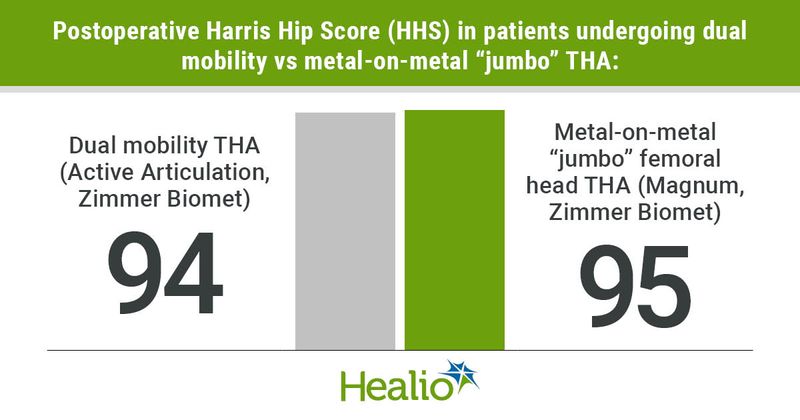Dual mobility vs. ‘jumbo’ femoral heads yield similar results for primary THA
Click Here to Manage Email Alerts
With comparable outcomes to large diameter metal-on-metal femoral heads, dual mobility total hip arthroplasty provides no benefit “beyond that of the large effective head size,” according to published results.
Mitchell Beckert, MD, and colleagues performed a retrospective cohort study that analyzed 1,288 metal-on-metal (MoM) “jumbo” femoral head THAs (Magnum, Zimmer Biomet) and 365 dual mobility (DM) THAs (Active Articulation, Zimmer Biomet) at a single institution between 2005 and 2018. According to the study, average head size in both cohorts was 50 mm. Outcome measures included Harris hip score (HHS), pain scores, dislocations and complications.

Overall, there were no dislocations in the DM cohort and two dislocations in the jumbo cohort. In the jumbo cohort, HHS improved from 47 preoperatively to 95 postoperatively. Similarly, HHS in the DM cohort improved from 45 preoperatively to 94 postoperatively. Postoperative pain score was 43 in the jumbo cohort and was 42 in the DM cohort. Twelve cases of aseptic loosening occurred in the MoM cohort, while no cases of aseptic loosening occurred in the DM cohort.
“The use of dual mobility articulations has grown substantially over the last decade to help minimize dislocation risk,” the researchers wrote in the study. “Both groups experienced dramatic improvements in HHS and pain scores from their preoperative baseline. Nevertheless, there appears there is no benefit to the additional articulation of DM designs beyond that of increased effective head size,” they concluded.
